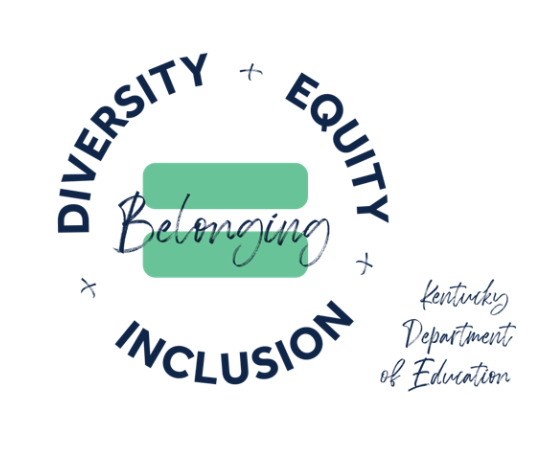
This page contains diversity, equity, inclusion and belonging resources for school leaders and educators.
The professional learning opportunities: are intended to support the Professional Standard for Educational Leaders (PSEL). Specifically, the offerings support PSEL Standard 3, Equity and Cultural Responsiveness: “Effective educational leaders strive for equity of educational opportunity and culturally responsive practices to promote each student's academic success and well-being."
Navigating the Page:
A quick way to search this page is to click the “ctrl” key and “f” key on your keyboard at the same time. Then in the box that opens in the top right corner of your screen, type in the key terms you are searching for and it will complete a search and tell you the number of times your key terms are on the page and will highlight the key terms throughout the page. If you have a Mac you will follow the same steps but instead click the “command” key and the “f” key at the same time to scan for the key terms you are looking for. Search for how to use the "ctrl f" feature to search quickly on youtube to see a video of this process.
Resources are organized by:
- Personal Learning / Training / Professional Learning Communities Resources
- Educator Wellbeing Resources
- Equity and Academic Resources
- KyMTSS & Trauma-Informed Practices Resources
- Addressing Harassment / Discrimination / Bullying Resources
- Using Data for Equity
- Understanding Policy & Law
- Important Terms and Definitions
Personal Learning / Training / Professional Learning Communities Resources:

| Cultural Competence
Through the A4 Framework
| –Learn the knowledge, skills and attitudes to increase your effectiveness in relating across cultural differences in increasingly diverse domestic and international environments. (A1) Awareness (A2) Acknowledgment (A3) Acceptance (A4) Action
–Reach out to Veda Stewart for access to this module. |
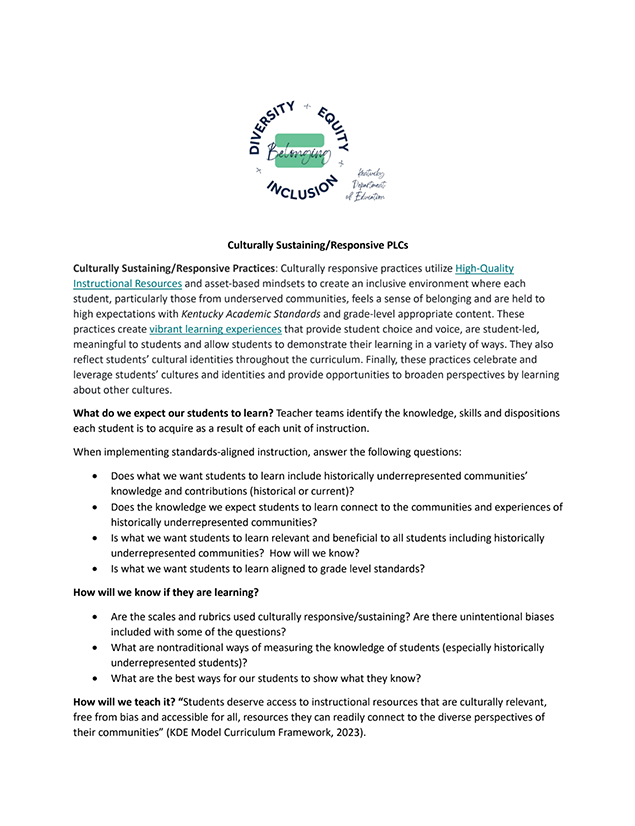
| Culturally Sustaining/Responsive PLCs
| –This two-page document defines culturally sustaining/responsive practices and provides a set of questions for leaders of professional learning communities to walk participants through with culturally sustaining/responsive practices in mind.
–Questions include: What do we expect our students to learn? How will we know if students are learning? How will we teach the content? How will we respond when some students do not learn? How will we extend learning to students who already know the content?
|

|
| –This 11-page document discusses ways schools can ensure equity, the Kentucky Department of Education’s role in diversity, equity, inclusion and belonging (DEIB) work, promoting student equity through standards implementation and frequently asked questions around terms.
–This document includes: An explanation of Kentucky’s Multi-Tiered System of Supports (KyMTSS) (p. 4) Tier 1 Equitable Practices (p. 5) Promoting Student Equity Through Standards Implementation (p. 6-7) Frequently Asked Questions (p. 9-11)
|
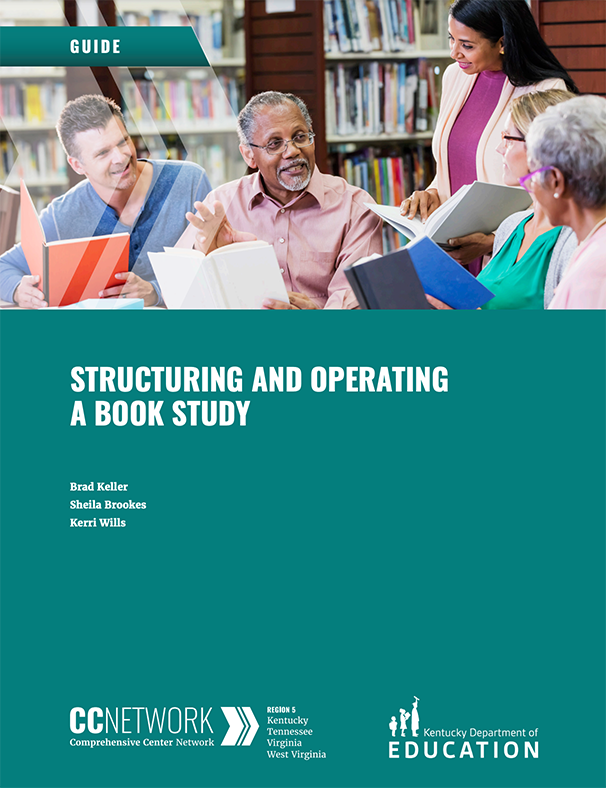
| Structuring and Operating a Book Study
| –This guide provides tools and suggestions for structuring and operating a book study for both in-person and online professional and educational settings.
–The guide includes: Considerations When Designing a Book Study (p. 4-9) Structuring the First Meeting of the Book Study (p. 9-20) Structuring Subsequent Meetings (p. 20) Examples or Exhibits of Book Study Tools (p. 7, 8, 10, 15, 18, 21)
Diversity, Equity, Inclusion and Belonging (DEIB) Book Studies: Sample Books
|
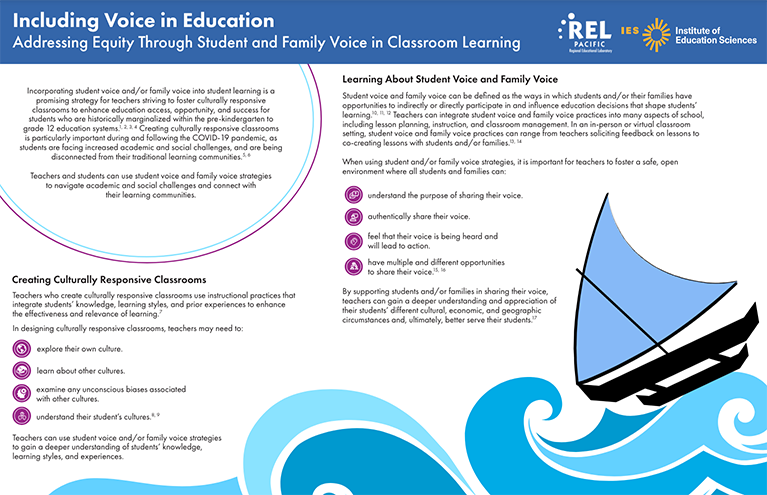
| Including Voice in Education
| –This five-page infographic shares quick themes and strategies around student and family voice for teachers to incorporate into their classrooms (both virtual and in-person).
–The infographic includes: Steps educators may take to create culturally responsive classrooms (p. 1) Important elements for safe environments that promote student and family voice (p. 1) Six student voice themes and 10 student voice strategies for teachers (five strategies for virtual classrooms and five for in-person classrooms) (p. 2) Diving deeper into 21 student voice strategies (p. 3) Five family voice themes and 10 family voice strategies for teachers (five strategies for virtual classrooms and five for in-person classrooms) (p. 4) Diving deeper into 16 family voice strategies (p. 5)
|
Educator Wellbeing Resources:

| Educator Wellbeing: 10 Wins for School Leaders
| –This document supports school leaders in upholding the Professional Standards of Educational Leadership (PSEL). The strategies listed are suggestions that may support standards implementation alongside other strategies.
–To support student wellbeing, educators must be well themselves. This list may serve as a list for school leaders to return to throughout the school year that can reaffirm and amplify the great work they are already doing to support educators as well as serve as a reminder of wins they may want to add. Educators may use this list to reaffirm their principal's great work and advocate for support needed.
|
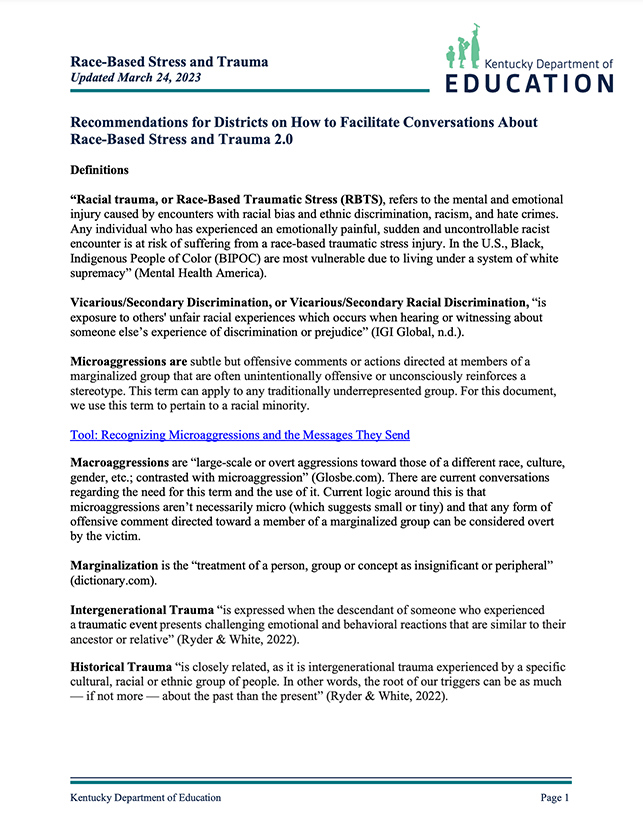
| Addressing Race-Based Stress and Trauma
| –This five-page document defines the following terms and discusses their impact on students and staff:- racial trauma
- vicarious/secondary discrimination
- microaggressions
- macroaggressions
- marginalization
- intergenerational trauma
- historical trauma
–Learn what you can do for: - your personal learning
- facilitating conversations in whole group (Tier 1) or small group (Tier 2)
- caregivers
- staff wellbeing and self-care
–Research shows that ignoring or avoiding race-related topics may increase harm while discussing these topics can reduce harm for all students (Gonzales, D, et al., 2022).
|
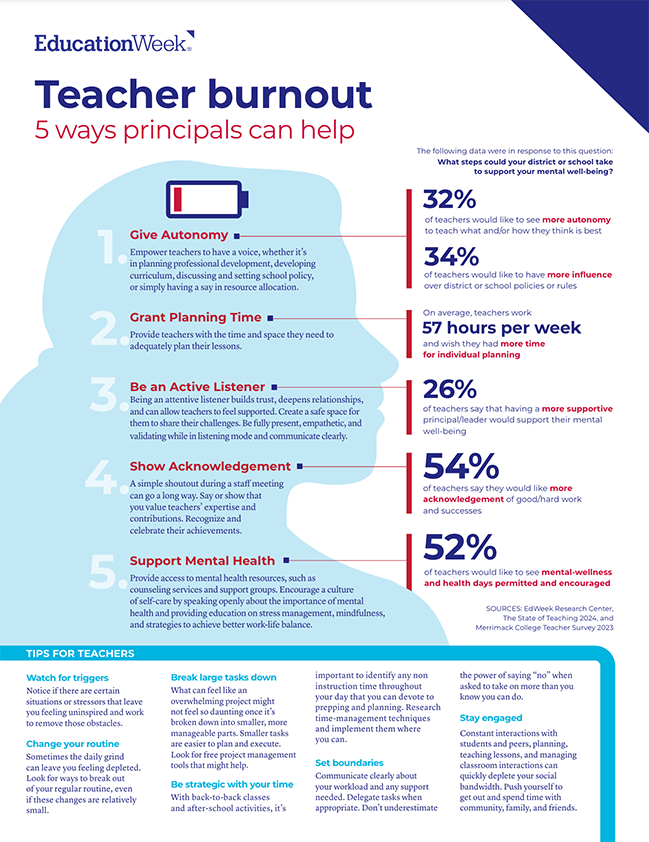
| EdWeek: Teacher Burnout 5 Ways Principals Can Help
| –This one page infographic shares 5 tips for principals and 5 tips for educators to address burnout and connects the tips to research.
–The 5 tips for principals include:
- Give Autonomy
- Grant Planning Time
- Be an Active Listener
- Show Acknowledgement
- Support Mental Health
|
Equity and Academic Resources:
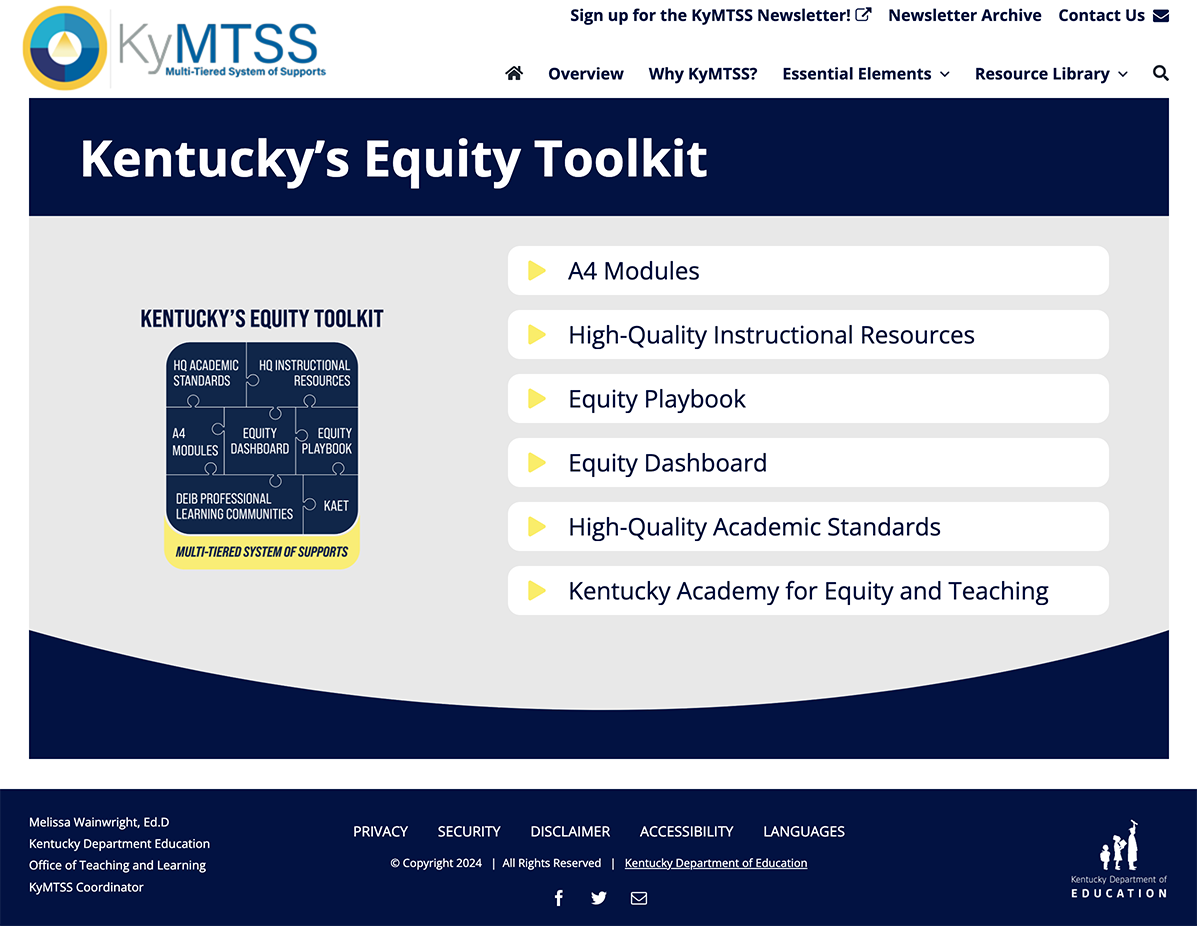
| The Equity Toolkit
| –Share this toolkit page when you wish to share multiple equity tools all in one place.
–This toolkit contains: - The A4 Cultural Competence Modules
- High-Quality Instructional Resources
- The Equity Playbook
- The Equity Dashboard for data
- High-Quality Academic Standards
- Kentucky Academy for Equity and Teaching
|
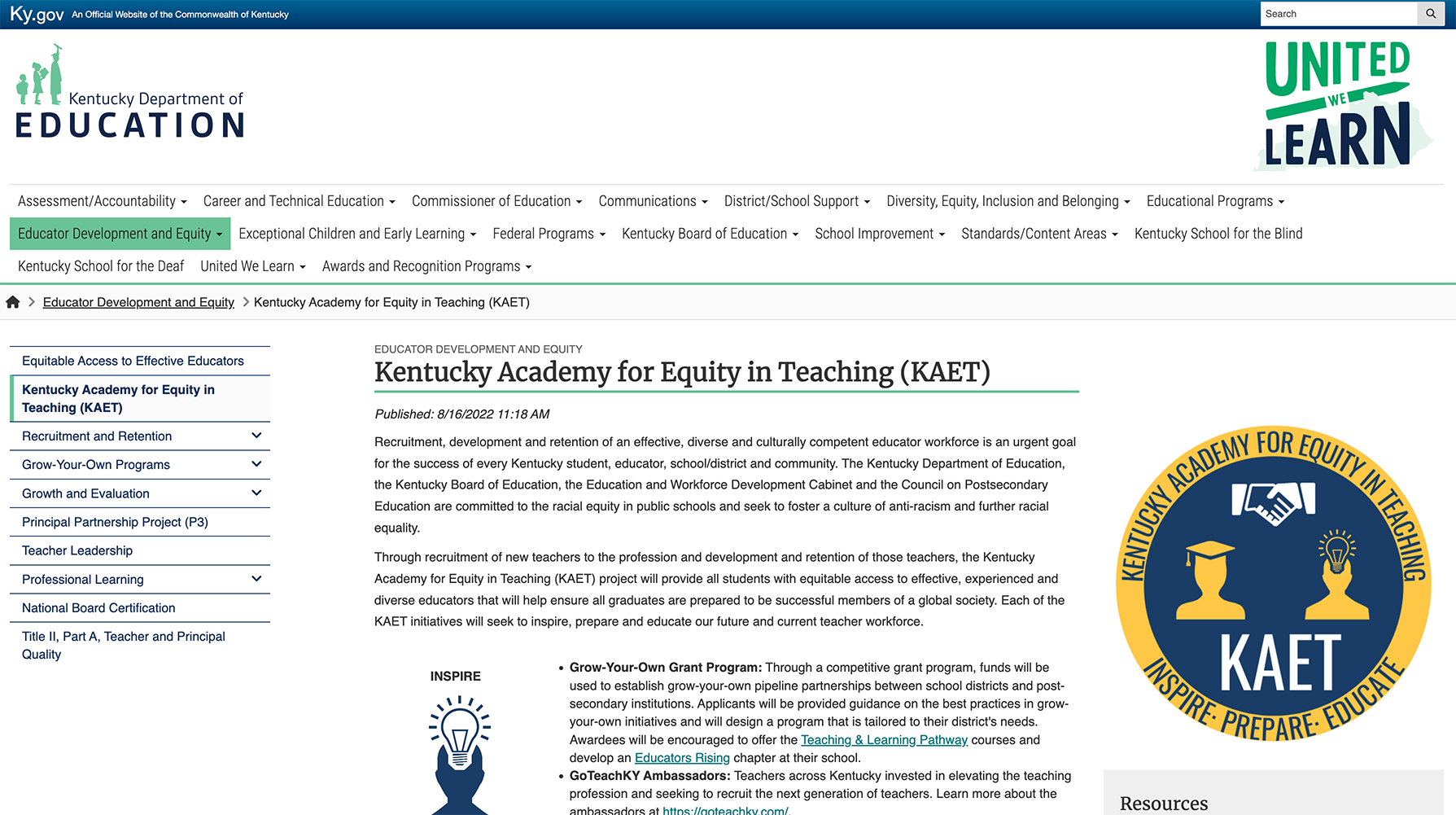
| Kentucky Academy for Equity in Teaching (KAET)
| –The KAET page is dedicated not only to the recruitment of minority teachers, but also the retention of minority educators to the profession. Visit the page to learn more.
|

| Your Students' Voices Matter: Commissioner's Student Advisory Council
| –Encourage your students to sign up to be a member of the Commissioner’s Student Advisory Council to meet monthly to discuss their educational experiences. If interested, you may email the contact on the bottom of the linked page.
|
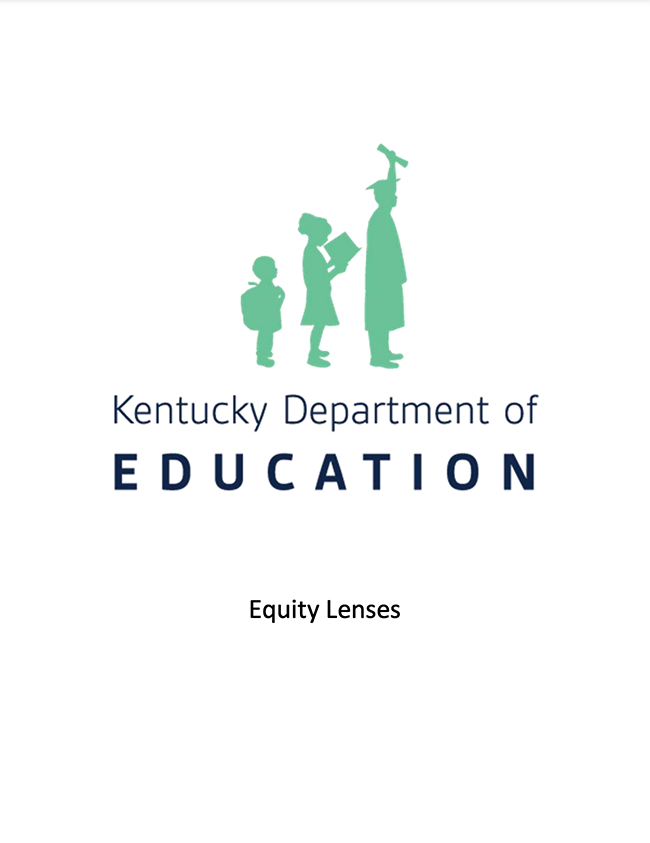
| Equity Lenses for High Quality Instructional Resources
| –This 12-page document is intended as a companion to the Model Curriculum Framework and it explains the equity lenses for High-Quality Instructional Resources (HQIRs).
–The document provides a four step process for how to use equity lenses in each step of instructional resource selection.
–The four steps of instructional resource selection include: - Determining selection criteria
- Identify potential HQIRs
- Evaluate potential HQIRs
- Select Instructional Resources
|
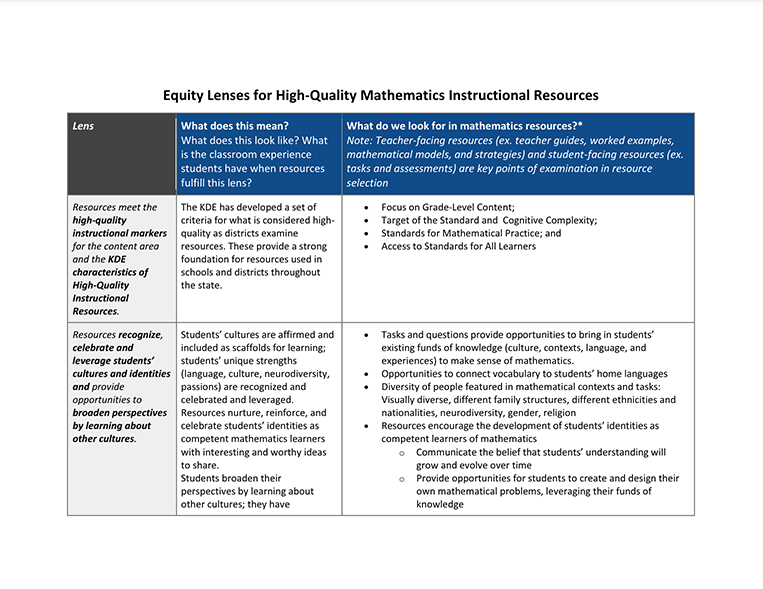
| Equity Lenses for High Quality MATHEMATICS Instructional Resources
| –This four-page document provides five lenses or criteria for equitable mathematics instruction, explains what these lenses or criteria mean/look like, and what you can look for within mathematics resources to assess whether or not the resources are equitable.
|
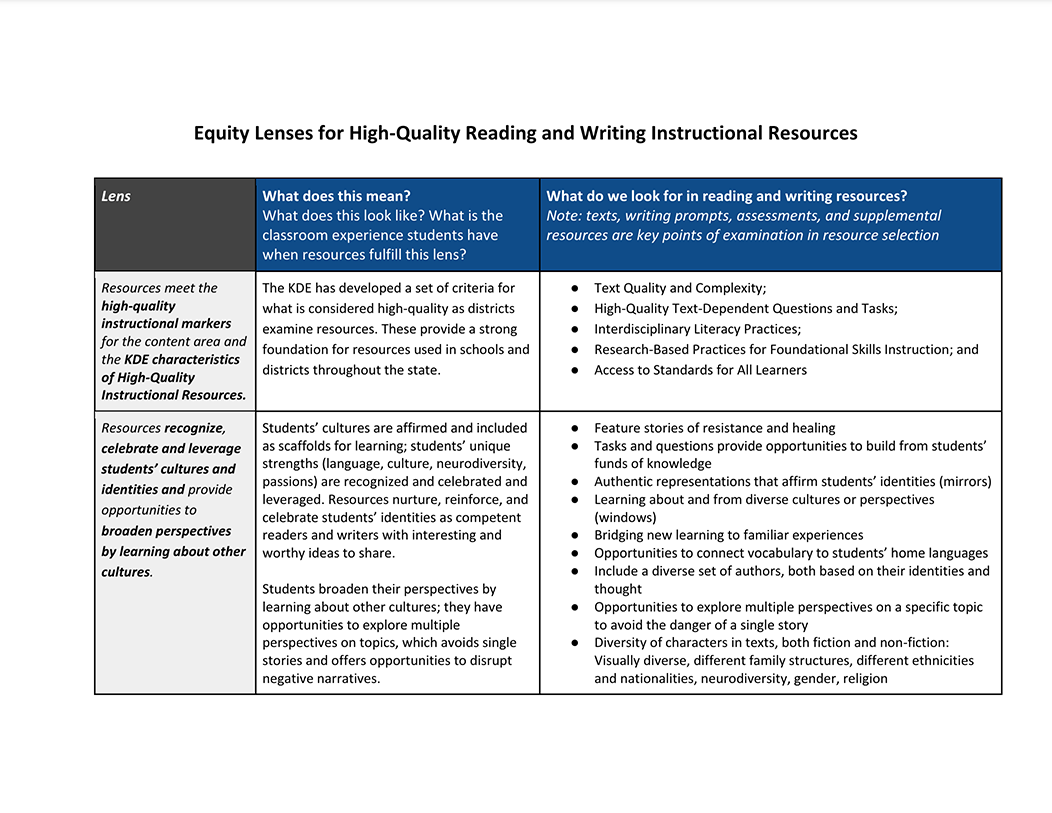
| Equity Lenses for High Quality READING and WRITING Instructional Resources
| –This three-page document provides five lenses or criteria for equitable reading and writing instruction, explains what these lenses or criteria mean/look like, and what you can look for within reading and writing resources to assess whether or not the resources are equitable.
|
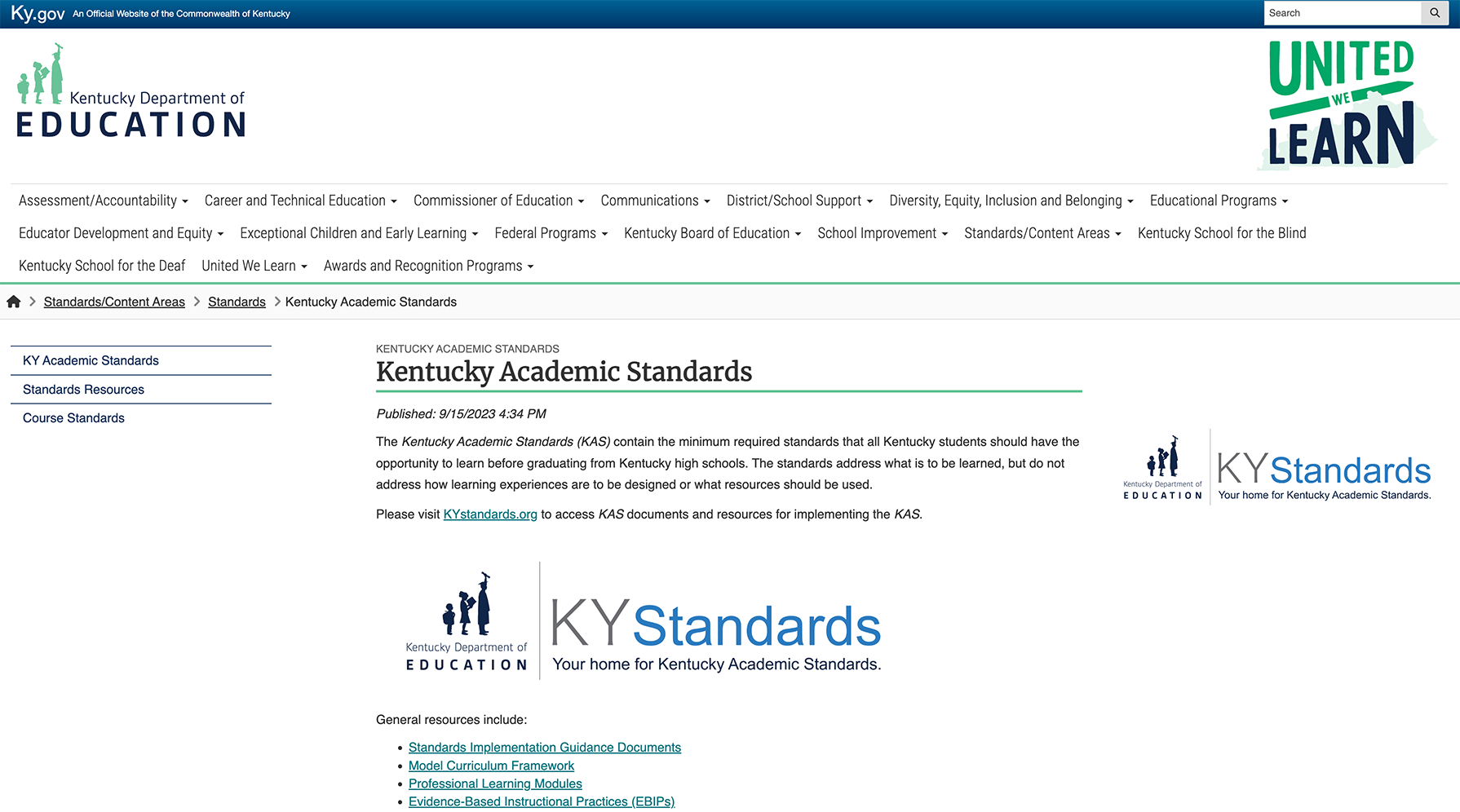
| Kentucky Academic Standards (KAS)
| –This page defines Kentucky Academic Standards (KAS) and provides links to the standards, general resources and content specific resources.
|
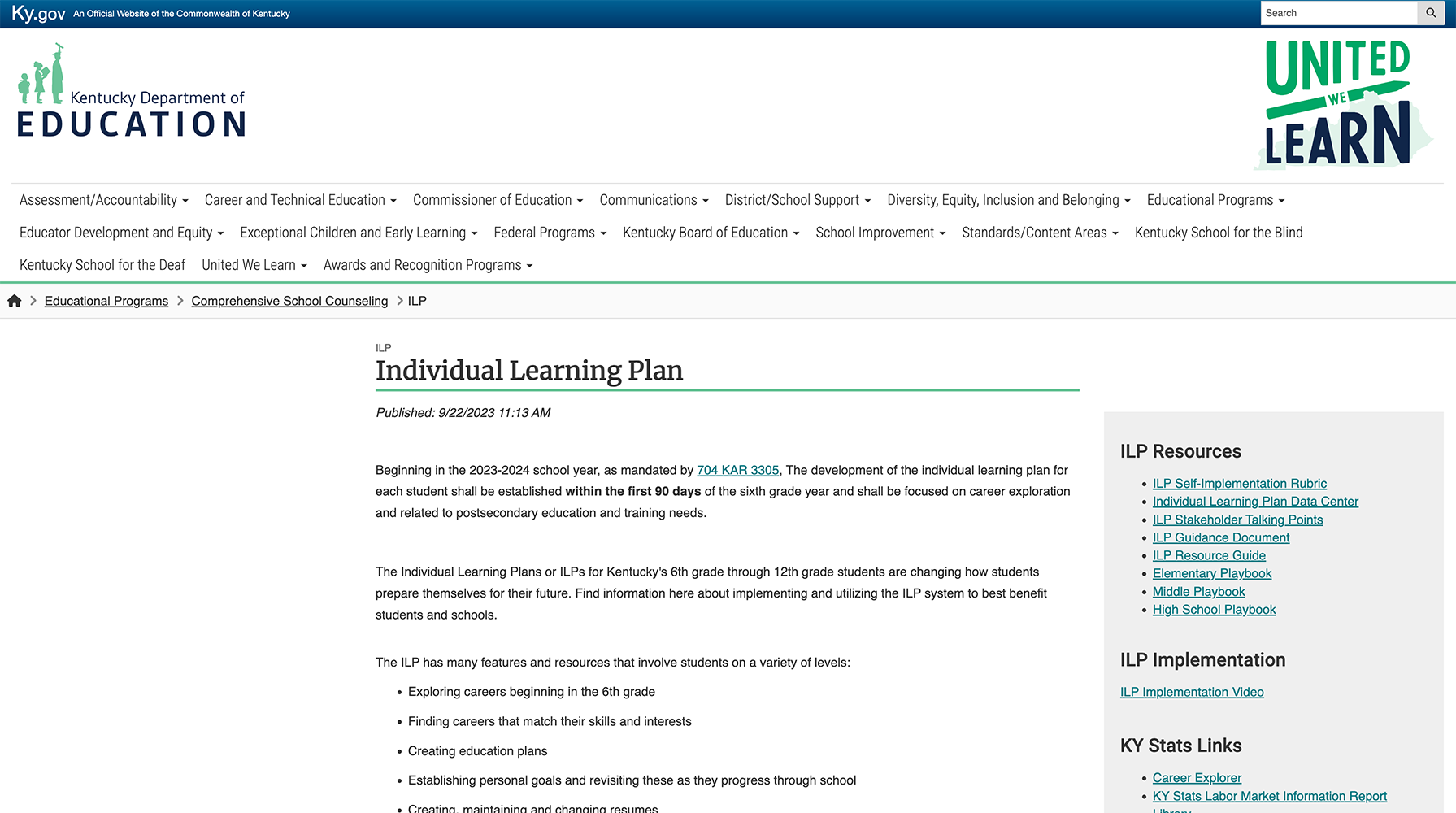 | Individual Learning Plan (ILP)
| –In 2023, it is mandated by 704 KAR 3305 that all 6th through 12th graders have an individual learning plan to focus on career exploration and life after high school.
|

| Advanced Coursework
| –Explore your advanced learning options by learning more about Advanced Placement (AP), Dual Credit, International Baccalaureate, Cambridge Advanced International and more. Once on the Advanced Coursework page, click on the links on the left hand side to explore.
|

| Career and Technical Education (CTE)
| –Learn about CTE dual credit and earning recognized industry certifications and credentials.
|
Trauma-Informed Practices Resources:
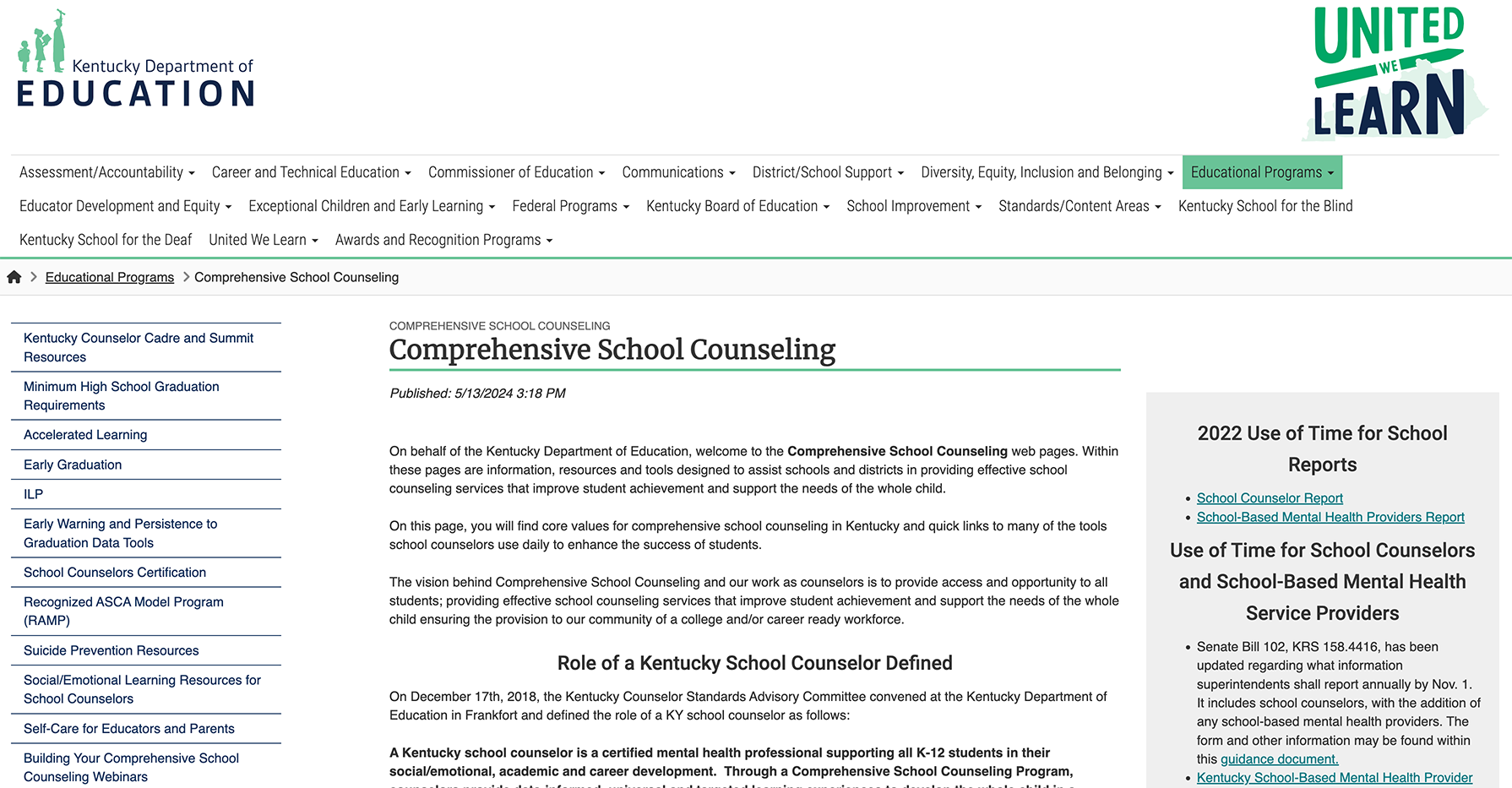
| Comprehensive School Counseling Page
| –This page explains comprehensive school counseling and provides resources including: - Role of a Kentucky School Counselor Defined
- Kentucky Framework of Best Practices for School Counselors
- Kentucky Multi-Tiered System of Supports for School Counselors
- 3 Domains of School Counseling
|

| Addressing Race-Based Stress and Trauma
| –This five-page document defines the following terms and discusses their impact on students and staff:- racial trauma
- vicarious/secondary discrimination
- microaggressions
- macroaggressions
- marginalization
- intergenerational trauma
- historical trauma
–Learn what you can do for: - your personal learning
- facilitating conversations in whole group (Tier 1) or small group (Tier 2)
- caregivers
- staff wellbeing and self-care
|
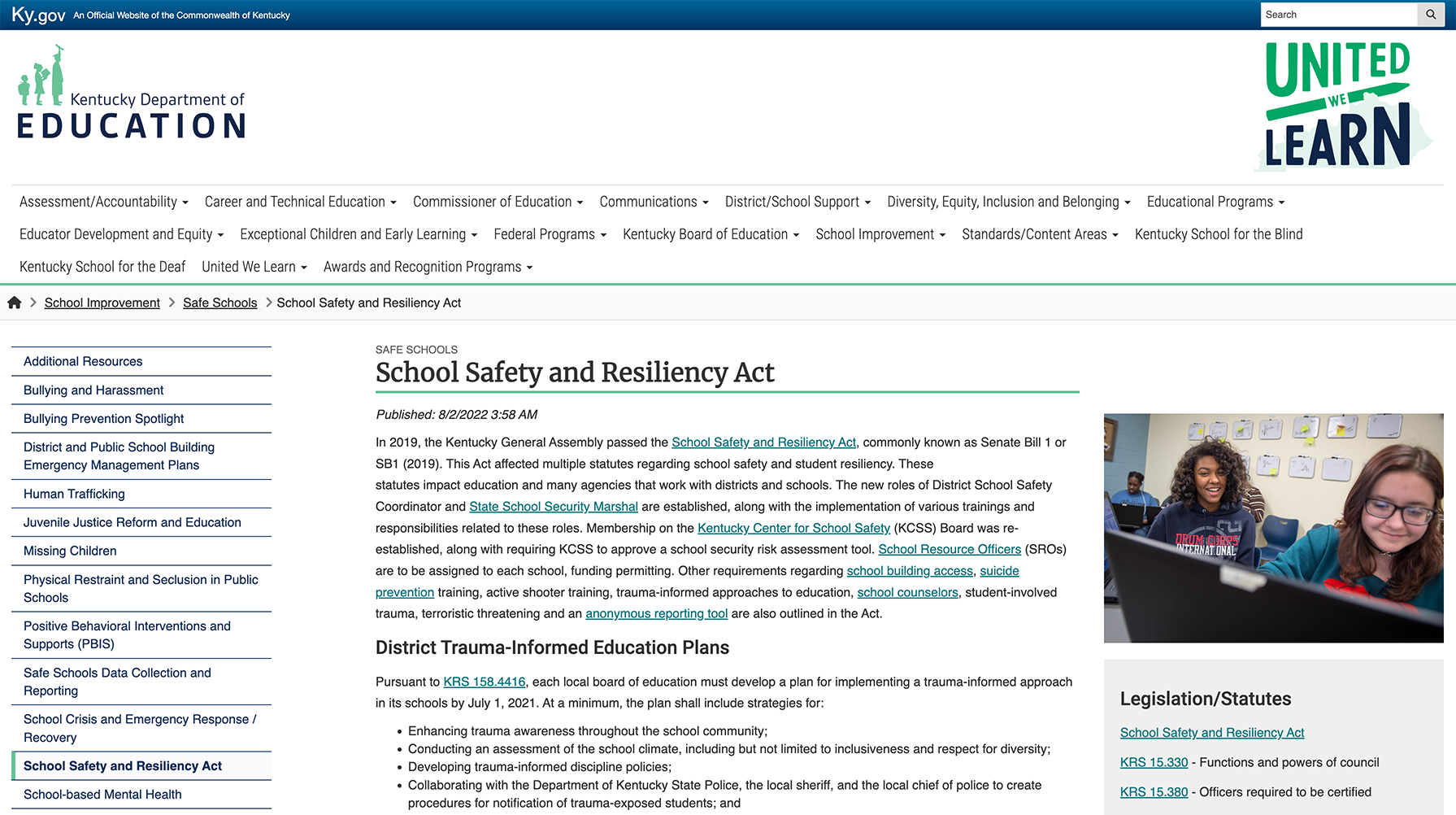
| Trauma-Informed Toolkit
| –Resources in the Trauma-Informed Toolkit include:- Understanding Trauma and Traumatic Stress
- What Is a Trauma-Informed School?
- Trauma-Informed Teams
- Trauma-Informed Active Shooter Drills
- Handle with Care
- Trauma-Informed Lockdown Drills
- Trauma-Informed Discipline Response and Behavior System
|
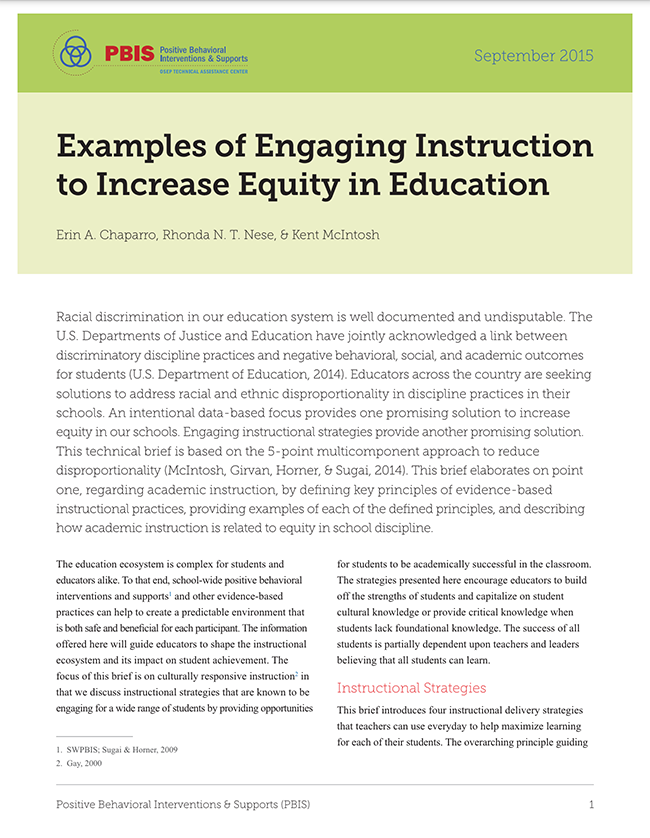
| Engaging Instruction to Increase Equity in Education
| –“This [six page] brief introduces four instructional delivery strategies that teachers can use everyday to maximize learning for each of their students. The overarching principle guiding all of these strategies is explicit instruction”
–The brief topics includes: - Overview of Instructional Strategies and Selected Supporting Evidence (p. 2)
- Explicit Instruction Features (p. 3)
- Build and Prime Background Knowledge (p. 3)
- Increase Opportunities to Respond (p. 4)
- Provide Performance Feedback (p. 4)
- Conclusion (p. 5)
- Resources (p. 6)
–Appendix A (p. 9-14) is an example of an explicit vocabulary lesson for third grade students that shows each of the principles discussed in the brief.
|
Addressing Harassment / Discrimination / Bullying Resources:
Using Data for Equity Resources:
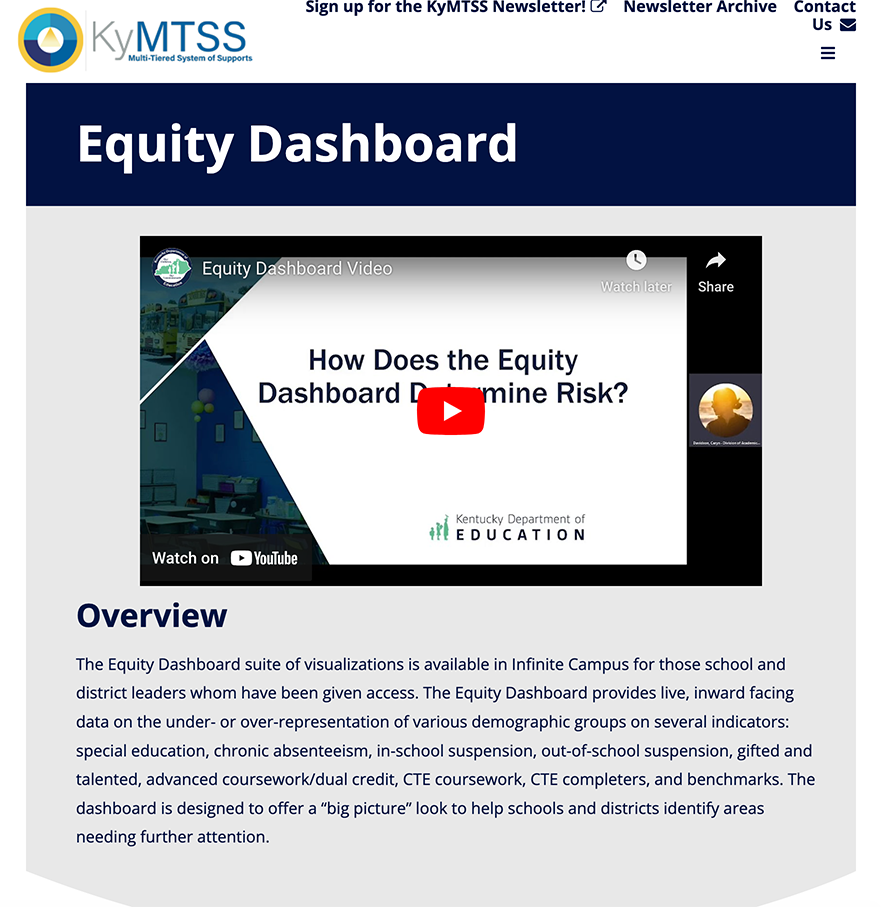
| The Kentucky Department of Education's Equity Dashboard (Data)
| –The equity dashboard provides live, inward facing data on the under- or over-representation of various demographic groups on several indicators: - special education
- chronic absenteeism
- in-school suspension
- out-of-school suspension
- gifted and talented
- advanced coursework/dual credit
- CTE coursework
- CTE completers
- and benchmarks
–The dashboard is designed to offer a “big picture” look to help schools and districts identify areas needing further attention.
–Reach out to your school leader to request data and find out who has access to the dashboard in Infinite Campus at your school or district.
|
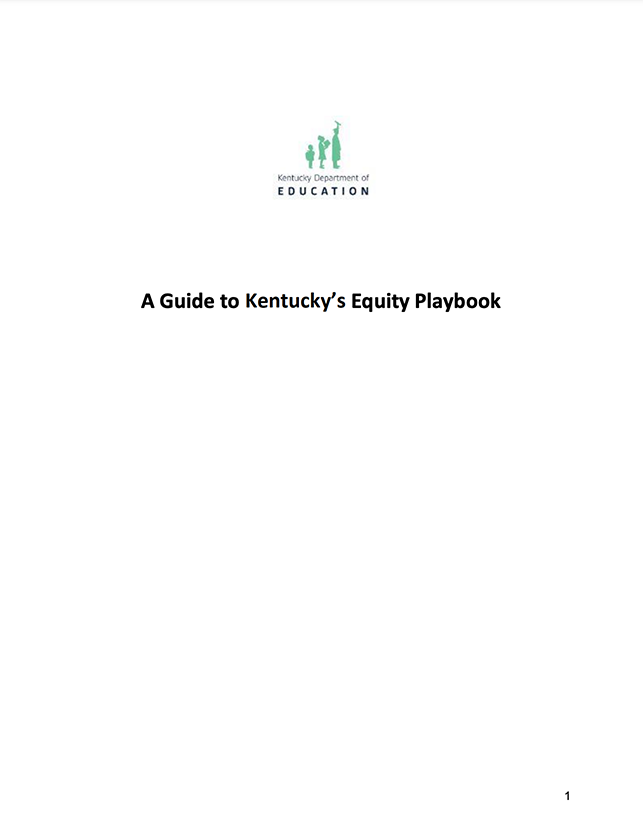
| A Guide to Kentuck's Equity Playbook
| –The equity playbook is a coaching initiative that trains coaches and school leaders on how to coach educators around equity problems of practice.
–The Kentucky Department of Education partnered with engage2learn (e2L), an education consultant firm, and Kentucky’s regional educational cooperatives from 2021 to 2024.
–LXD, an independent research group, found in the first year of the Equity Playbook data that among schools with a high percentage of economically disadvantaged students, students attending Equity Playbook schools became more likely to test on grade level in Science and Math than their comparison school peers.
–Use this guide to (p. 6-7): - Select an equity pillar problem of practice
- See examples of a data analysis protocol around equity pillar problems of practice
- Reflect and critique your problem of practice
- Discuss your problem of practice and accountability with your coach
–The equity playbook addresses 5 equity pillars (defined on p. 8 with examples on pages listed below): - Student achievement (p. 10)
- Utilization of funding and resources (p. 14)
- Disproportionality relative to student discipline (p. 12)
- Culture and climate (p. 11)
- High effective staff and high-quality instructional resources (p. 13)
|
Important Terms and Definitions:
Equity: The promotion of access, opportunity and advancement of all individuals, including those in underserved communities, in order to identify and eliminate conditions that prevent the ability of all students to reach their full potential. See our homepage for a definition of underserved communities.
Culturally Sustaining/Responsive Practices: Culturally sustaining/responsive practices utilize High-Quality Instructional Resources and asset-based mindsets to create an inclusive environment where each student, particularly those from underserved communities, feels a sense of belonging and are held to high expectations with Kentucky Academic Standards and grade-level appropriate content. These practices create vibrant learning experiences that provide student choice and voice, are student-led, meaningful to students and allow students to demonstrate their learning in a variety of ways. They also reflect students’ cultural identities throughout the curriculum. Finally, these practices celebrate and leverage students’ cultures and identities and provide opportunities to broaden perspectives by learning about other cultures.
Asset-based language: Language that affirms a positive and growth-mindset about students in which the individual focuses on strengths and views students as capable of the essential skills and attributes associated with academic success, motivation, self-efficacy and individual effort. For example, students who are learning to speak English might be called “multilingual learners” to focus on their strength in learning to know more than one language rather than saying “English language learners” which focuses on an area students need to learn and improve upon (Fitchburg State University, Policy Review With An Equity Lens).
Culture: Each individual has their own cultural norms informed by their family, communities and lived experiences. There are three levels of culture (Hammond, Jackson, & Corwin, 2015).
- Observable elements, such as food, music, dress and holidays, have a lower emotional charge.
- Unspoken rules and social norms, such as, nonverbal communication, eye contact, personal space, have a strong emotional charge.
- Worldview (such as core beliefs and group values), cultural archetypes (such as collective vs. individual) and mental models (such as funds of knowledge) have an intense emotional charge
Thomas S. Tucker, Ph.D.
Office of Teaching and Learning
300 Sower Blvd., 5th Floor
Frankfort, KY 40601
502-564-2106 Ext. 4840